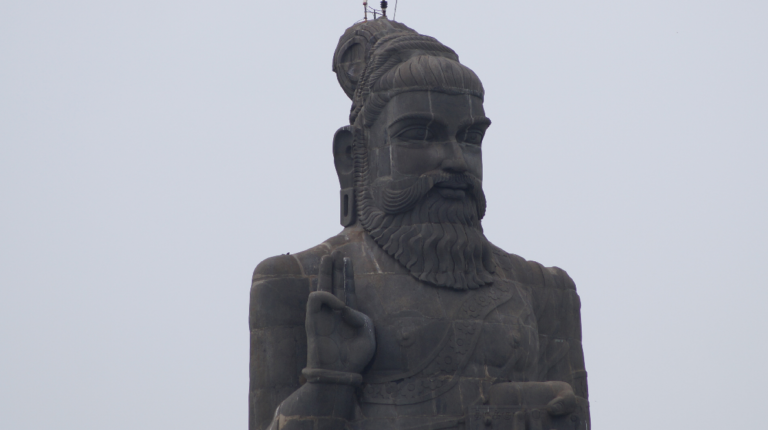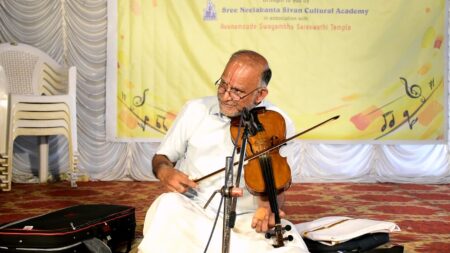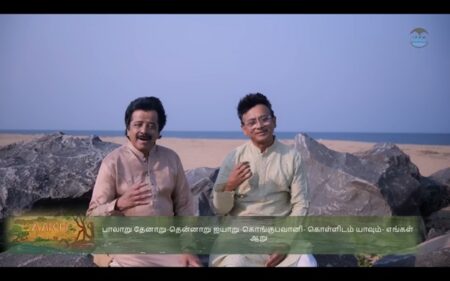Preeminent philosopher Thiruvalluvar’s masterpiece, Tirukkural, has been set to an innovative presentation and was premiered on Thiruvalluvar day
The ancient Tirukkural earned a new aura of musicality this week when 13 Carnatic vocalists rendered the 1,330 couplets of the Tamil classic in an uncustomary style. Usually sung in the rhythm-free virutham format, the two-liners of seven words each were this time set to ragas common as well as rare in Indian classical. There was a fresh approach to the tala section too, as the cycles ranged from simple to complex.
The experimental venture was premiered on Facebook and YouTube as a part of Thiruvalluvar day(January 16) observed in memory of the author of the work on the ethics of virtue, wealth and love. The endeavour was as a tribute by Kala Prashala, a US-based online platform that is into popularising arts and culture, particularly music and dance. The team behind the January 16 presentation, comprised both experienced and emerging vocalists. Chitravina maestro N Ravikiran set the tunes, which were sung in turns by Sikkil Gurucharan, Abhilash Giri Prasad, Kruthi Bhat, Anahita Ravindran and Apoorva Ravindran, Vanitha Suresh among others .
Impulsive inspiration
It was in 2016 Ravikiran set to tune the Tirukkural, mainly in Carnatic and Hindustani ragas besides certain folk scales. The project has its genesis tracing to politician-diplomat Gopalkrishna Gandhi selecting 34 Tirukkural couplets and asking the Carnatic instrumentalist to tune them. The verses are believed to have been written between the 2nd century BC and 5th century AD.

The Tirukkural assignment inspired Ravikiran to tune the entire text. He gave music to the 1,330 verses in a record 16 hours, which was less than a third of the original time slotted for the project. Ravikiran completed the task in three sessions over as many days in early 2016 at Chennai. The public and the media watched the January 12-14 composing work at the International Institute for Tamil Studies.
“Actually, I conceptualized the entire project during a car drive in Chennai,” says Ravikiran, who divides times between India and America. “It is typically one raga per adhikaram (a group of 10 couplets), leave alone the ragamaalikas (multi-melody passages).” The composer chose to treat each adhikaram like a varnam or a kriti, with ample scope for improvisations Carnatic musicians do with neraval and swarams.
The couplets have been composed in such a way that it leaves scope for a full-length Tirukkural concert. The ragas range from the invocatory Gambheeranattai and Hamsadhwani to the profound ghana-category Nattai, Arabhi, Sree and Varali to those called rakti, such as the delightful Sahana, Yadukulakamboji, Anandabhairavi, Punnagavarali, Mohanakalyani and Hindolam. Ahir Bhairav figures among the Hindustani ragas.
Ravikiran also employed a wide variety of rhythms while tuning the kurals. The uncommon among them includes Misrajathi mathyatalam, Chaturashra Atatalam, Mishra Triputa while sometimes the cycles would resort to a kaleidoscopic talamalika or stick to different tempos. One of the rare ragas was Neelamani.
The extra challenge
What primarily inspired Ravikiran to take up the Tirukkural project was the 13th-century poet Vendatha Desika, who composed 1,008 verses of Paduka Sahasram overnight in the Srirangam temple in Trichy. “There are Tirukkural tunes set by Mayuram Vishwanatha Shastri and Dandhapani Desikar. Other musicians, too, have sought to fit some of them into talas, but the verses don’t easily lend themselves to music,” adds the master, who will turn 54 next month.
Ravikiran’s own experience in composing Sangam-era literature came to his support. Those works include Agananooru, Purananooru and thevarams, besides works of Purandara Dasa and a few of Ravikiran’s contemporaries apart from his own compositions. “As for this project, the idea was to maintain the integrity of Tiruvalluvar’s lines. I wanted to set it to music in a manner that is concert-ready,” says Ravikiran. “Tala was the key to maintain the integrity of Thiruvalluvar’s meter, where the second line of the couplet is shorter than the first. “Else, it may sound very crowded in the first line and spaced out in the second.”
To compose in a public space was a “challenge”, but the music training from his father “helped me a lot”, he feels. “I was going adhikaram after adhikaram, and then some raga and tala would strike and I would sing. Some adhikarams were easy; others were challenging especially in terms of tala. I have used yathibhedams too, inspired by composers. One being Oothukadu Venkatakavi”.
On February 7, Mani Krishnaswamy Academy, an online platform for popularising Carnatic music is premiering this tirukkural composition that will be rendered by vocalists including Nithyasree Mahadevan, Delhi Muthukumar, V K Arun Kumar, Selam Shriram.
Kala Prashala is also planning to come up with Tirukkural concerts, says the forum’s artistic director HL Kumar. “It will be interesting to see if performers take to the Tirukkural the way they have to, say, the Tiruppavai,” he notes, referring to saint Andal’s verses in praise of Lord Vishnu.




